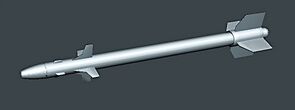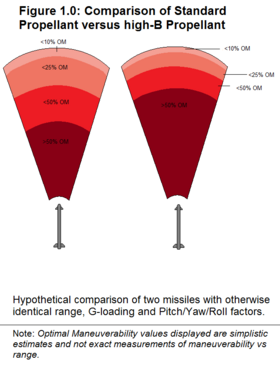C-80 Stilétto: Difference between revisions
ContraViper (talk | contribs) No edit summary |
ContraViper (talk | contribs) |
||
| (2 intermediate revisions by the same user not shown) | |||
| Line 35: | Line 35: | ||
|guidance= Electro-Optical Infrared Imaging | |guidance= Electro-Optical Infrared Imaging | ||
}} | }} | ||
The '''C-80 Stilétto''' is an advanced Intermediate Range Air-to-Air Missile (IRAAM) developed for the air forces of [[Inyursta]]. It is designed to serve as a complement to the [[C-120 Rapier]] and [[C-120 Rapier|C-170 Rapier II]] long-range air-to-air missiles, and the {{wp|AIM-9 Sidewinder#AIM-9X| | The '''C-80 Stilétto''' is an advanced Intermediate Range Air-to-Air Missile (IRAAM) developed for the air forces of [[Inyursta]]. It is designed to serve as a complement to the [[C-120 Rapier]] and [[C-120 Rapier|C-170 Rapier II]] long-range air-to-air missiles, and the {{wp|AIM-9 Sidewinder#AIM-9X|C-9Y3 Sabre}} short-range air-to-air missiles, made to operate in the "gray area" between BVR and WVR. | ||
It is named for a long, thin and nimble assassin's knife or switchblade. | It is named for a long, thin and nimble assassin's knife or switchblade. | ||
| Line 42: | Line 42: | ||
Conceptualization of the missile stands in line with the [[Inyurstan Air Force|Inyurstan Air Force's]] Distance-Direction-Altitude Control (D2AC) doctrine for air-to-air combat. It is designed to be a high-speed, high-agility missile to bridge the gap between their long-range and short-range missile, as well as giving frontline fighters an effective and deadly option for first-shot-first-kill when entering the edge of visual range. | Conceptualization of the missile stands in line with the [[Inyurstan Air Force|Inyurstan Air Force's]] Distance-Direction-Altitude Control (D2AC) doctrine for air-to-air combat. It is designed to be a high-speed, high-agility missile to bridge the gap between their long-range and short-range missile, as well as giving frontline fighters an effective and deadly option for first-shot-first-kill when entering the edge of visual range. | ||
There is a measure of debate in the military-aviation community on whether the missile was designed initially for Inyursta's {{wp|Lockheed Martin F-22 Raptor| | There is a measure of debate in the military-aviation community on whether the missile was designed initially for Inyursta's {{wp|Lockheed Martin F-22 Raptor|AC-22M Mussurana}} and [[AC/A-92 Night Adder]] stealth fighters as an added layer of range control, or for its 4.5th generation [[AC-88 Taipan|AC-88E Taipan Block II]] and [[Amérifighter EF-20|AC/A-20 Crotaléa]] as a means of successfully engaging enemy stealth fighters at an optimum distance. Regardless, the missile is purportedly planned to be deployed on all four aircraft. | ||
It's official maximum range (A-Pole) is "greater than or equal to 80 kilometers"; however, the missile is optimized for use with a 20 - 50km engagement envelope. | It's official maximum range (A-Pole) is "greater than or equal to 80 kilometers"; however, the missile is optimized for use with a 20 - 50km engagement envelope. | ||
Latest revision as of 05:44, 14 March 2022
| C-80 Stilétto | |
|---|---|
 C-80 Stilétto IRAAM | |
| Type | Intermediate Range Air-to-Air Missile (IRAAM) |
| Place of origin | |
| Service history | |
| In service | 2017-present |
| Used by | |
| Production history | |
| Designer | Navayelle Systems |
| Designed | 2014 |
| Manufacturer | Navayelle Systems |
| Produced | 2017-present |
| Specifications | |
| Weight | 110kg |
| Length | 3.2m |
| Diameter | 16cm |
| Warhead | Annular Blast-Fragmentation |
| Warhead weight | 7.4kg |
Detonation mechanism | Laser Proximity Fuse |
| Wingspan | 68cm |
| Propellant | High-Boron Solid Propellant |
Operational range | >80km |
| Speed | Mach 4 |
Guidance system | Electro-Optical Infrared Imaging |
The C-80 Stilétto is an advanced Intermediate Range Air-to-Air Missile (IRAAM) developed for the air forces of Inyursta. It is designed to serve as a complement to the C-120 Rapier and C-170 Rapier II long-range air-to-air missiles, and the C-9Y3 Sabre short-range air-to-air missiles, made to operate in the "gray area" between BVR and WVR. It is named for a long, thin and nimble assassin's knife or switchblade.
Design
Concept
Conceptualization of the missile stands in line with the Inyurstan Air Force's Distance-Direction-Altitude Control (D2AC) doctrine for air-to-air combat. It is designed to be a high-speed, high-agility missile to bridge the gap between their long-range and short-range missile, as well as giving frontline fighters an effective and deadly option for first-shot-first-kill when entering the edge of visual range.
There is a measure of debate in the military-aviation community on whether the missile was designed initially for Inyursta's AC-22M Mussurana and AC/A-92 Night Adder stealth fighters as an added layer of range control, or for its 4.5th generation AC-88E Taipan Block II and AC/A-20 Crotaléa as a means of successfully engaging enemy stealth fighters at an optimum distance. Regardless, the missile is purportedly planned to be deployed on all four aircraft.
It's official maximum range (A-Pole) is "greater than or equal to 80 kilometers"; however, the missile is optimized for use with a 20 - 50km engagement envelope.
Missile Dynamics
A primary feature of the C-80 is its Forward Dithering Canards and Free-Spinning Tail fins (DC-FST), wherein the frontal canards rotate under the control of the missile seeker, and the tail fins are not in a fixed position, allowing them to rotate along the Z-axis of the missile frame. Despite term "free spinning" the tail fins are held in place by the wind vortices passing across the canards in all but the most extreme turning conditions - this effectively transfers control of the rearward fin surfaces to the forward fins. Studies during the late Cold War determined that the DC-FST combination in low angles of attack was almost indistinguishable from the aerodynamic performance of a similar missile with fixed tail fins; however, at higher angles of attack and higher supersonic speeds it demonstrated improved roll & yaw control allowing for a missile with enhanced maneuverability at higher speeds.
Gyroscopic rollerons are mounted on the forward canards instead of the tail fins, giving the frontal surfaces control of both direction and Z-axis stability, while allowing the seeker to implement standard proportional-pursuit. It also features a thrust-vectoring nozzle, further adding to the missile's maneuverability and turning control.
The C-80 is powered by a high-boron propellant which provides nearly three times the specific impulse versus most conventional solid rocket motor propellants. This gives the C-80 not just an expanded effective range, but an expanded envelope of maneuverability at greater ranges (see Figure 1). Improved engine output also adds significant range to the No-Escape-Zone (NEZ) of the C-80.
Seeker & Warhead
Guidance is provided by a 320×240 pixel dual waveband electro-optical imaging seeker for high target acquisition and discrimination. as well as a fire & forget method of operation. The C-80 Stilétto features both lock-on-after-launch (LOAL), lock-on-before-launch (LOBL) modes, as well as high off-boresight capabilities. Infrared counter-counter-measures (IRCCM) are equipped for added resistance to enemy counter-measures and evasion techniques.
A lightweight annular blast-fragmentation warhead loaded with copper rods is mounted at the front of the warhead. The 7.4kg explosive warhead is small compared to those of other AAM's with similar ranges and roles, and provides an effect lethal radius of roughly 6-9m at the time of explosion. Detonation is triggered by a laser proximity fuse.
Service History
Production began in early 2017, and the first units were delivered at the end of the following summer. As of October 2018, the C-80 Stilétto has yet to be fired in combat. It was believed that they were rushed into service prior to the San Meresque Incident, but were never used.
No exports of the missile have been planned so far; however, Navayelle Systems Inc. has expressed interest in developing a scaled-down export version for foreign customers.
